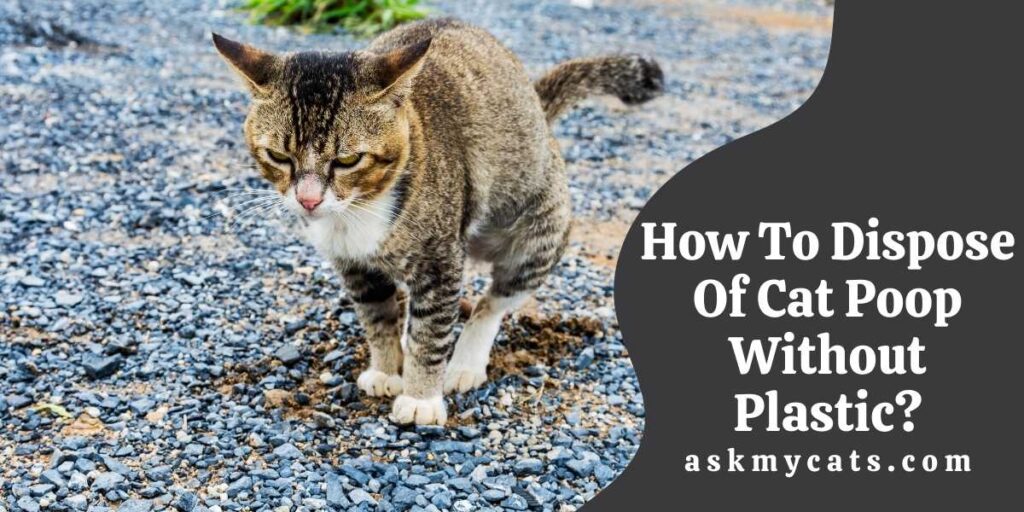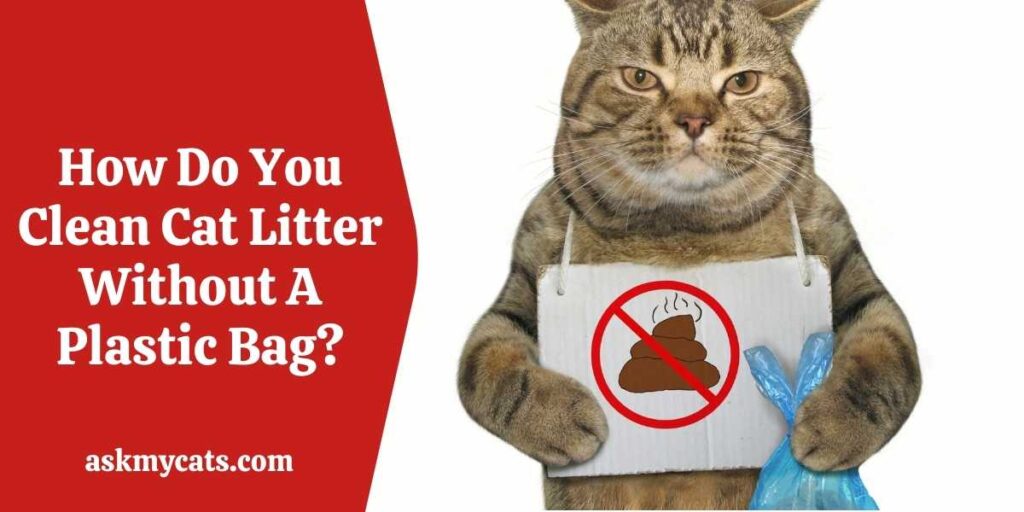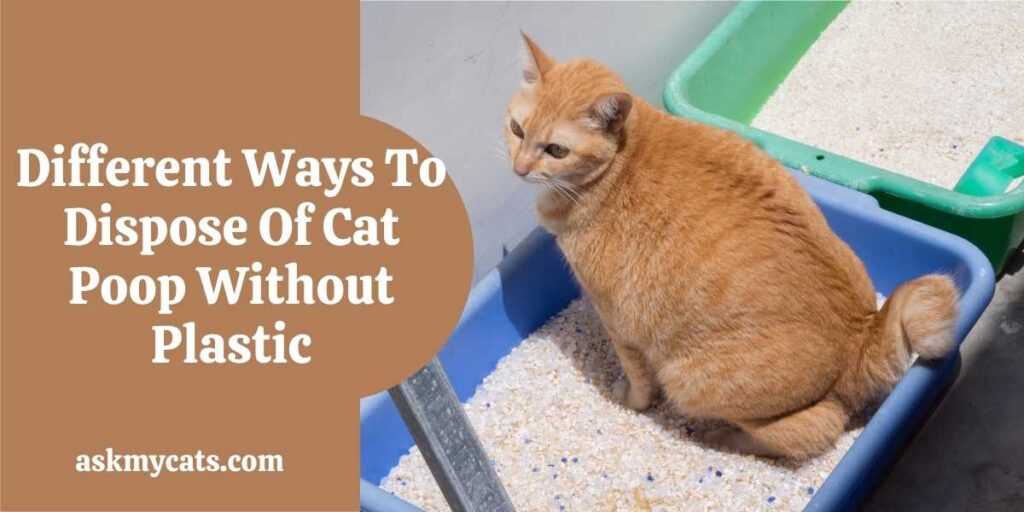People are being actively pushed to abandon single-use plastic bags in favor of more eco-friendly alternatives. Poop is collected in plastic bags by cat owners, who either deposit it in supplied containers or take it home.
Plastic bags are a practical way for cat owners to gather excrement and wet clumps from the litter box, tie the bag to avoid odours, and then dispose of it in the trash.
The two most common methods to dispose of cat poop without using plastic bags are either to compost the poop or to bury the litter in the ground.
Have you ever wondered how to dispose of cat poop in an environmentally friendly manner properly?
Pet owners can now dispose of litter left behind by their cats using plastic bags. The bags’ purpose is to assist you in collecting and disposing of cat poop in real-time. So you’ve been considering utilizing plastic bags to clean up cat poop around your house.
Before you do that, you might want to consider exploring alternatives, and the reasons listed below will convince you that you should.


Give Your Cat the Perfect Day
Get the Free Ebook!
How Do You Clean Cat Litter Without A Plastic Bag?
You can use biodegradable pet waste bags instead of a regular plastic bag to clean your cat’s litter.

Caring for a pet, mainly a cat may be difficult. On the one hand, you’ll want to make sure your pet is clean at all times. However, you will be concerned about living a plastic-free life to improve the planet’s health.
It’s possible that you won’t be able to perform one of them well without sacrificing on the other. As a result, pet owners should think about not using plastic bags to dispose of cat litter.
According to proponents of the initiative, it makes it simpler for such pet owners to live a plastic-free life, preserve the environment from abuse of plastics, and keep their cats healthy. As a result, it’s a win-win situation for everyone.
It’s no secret that switching to a different manner of disposing of your cat’s litter can be challenging for some pet owners. But it’s something you’ll have to get used to since the world is moving toward sustainability, and you and your pet can’t afford to be left behind.
If you really must give up plastic bags, you may console yourself by using cat litter to beautify your gardens. Fortunately, it may also be used as manure to help your plants flourish.
It’s worth noting that some pet owners regard a biodegradable bag to be a viable method of eliminating their cat’s litter. The move is not unrelated to dumping trash in a compost bin may not be the best option since enzymes to break it down may be lacking.
As a result, utilizing a biodegradable bag is the best option because it contains the necessary warmth to break down the cat litter. When utilizing this option, the general guideline is to scoop the water into the litter first before disposing of it in the biodegradable bag.
The best solution is to scoop and discard the kitty litter into a biodegradable collection bag before throwing it out in your curbside rubbish.
When you’re ready to change the cat litter in the box in the next 30 days, dump the cat litter onto a newspaper and discard it into your trash bin.
Some of your newspapers are no longer in circulation. It is suggested that you recycle these newspapers into something more creative, such as producing your trash.
In this situation, you will be transforming it into a biodegradable cat litter alternative that will combat the scents that the litter produces.
You might be tempted to flush your cat’s excrement down the toilet because you think it’s a better option than using plastic bags to dispose of cat litter. It may be quick, but it is also highly environmentally friendly, exactly what we want.
Flushing your kitty litter down the toilet can pose several health risks, including the loss of marine life and the tainting of our rivers. If the cat’s litter is infected, this is a possibility.
It’s lovely to use grass seed as an alternative to disposable bags for disposing of cat litter. For one thing, you can rest assured that it will not spread dust, and it will efficiently combat odours caused by trash.
Dumping the kitty litter onto a compound pile would be perfect if you use the compost method. In this scenario, the overall goal is to keep the distance between the pile and the site where food is grown (the garden) as long as possible.
Apart from using plastic bags to dispose of cat litter, there are a few more key rules to follow. These tips can considerably assist you in properly disposing of kitty litter.
Disposable scoops should not be used. Metal scoops, which can be readily kept and cleaned with vinegar and castile soap, are preferable to plastic scoops for preventing contamination.
Different Ways To Dispose Of Cat Poop Without Plastic

While many of these approaches aren’t completely plastic-free, there is no such thing as a perfect litter-disposal option. It’s a challenging task to balance environmental friendliness, safety, and ease.
However, by making any of these modifications, you’ll be lowering your carbon footprint as well as your cat’s.
1. Litter Disposal System
Litter disposal systems are odour- and bacteria-sealing containers that hold pet waste until it can be disposed of in the garbage.
You won’t need to empty until the multi-gallon capacity is filled because they thoroughly seal odours. As a result, the amount of plastic utilized in every litter box cleaning may be significantly reduced.
Unfortunately, ordinary biodegradable liners are still comprised of plastic. Simply plastic that has been treated with an ingredient causes it to break down significantly more quickly than a typical plastic bag.
There are biodegradable alternatives available from third parties. Most will still function with any appropriate-sized, biodegradable bag.
2. Composting
Our recommended technique of totally plastic-free litter disposal is composting.
Composting your cat’s waste will not only help to reduce the amount of plastic and filthy litter that ends up in landfills, but it will also provide a nutrient-rich fertilizer that can be used to feed ornamental plants and lawns.
If you have a weaker immune system, cat excrement includes the bacterium Toxoplasma gondii, which can cause toxoplasmosis. Pregnant women, young children, and anyone with disorders that impair the immune system should be highly cautious.
Do not put cat feces in your home compost on anything edible or in any location where you could come into touch with it. During the composting process, the bacteria may or may not be destroyed.
When appropriately utilized, cat excrement may be turned into a powerful and effective fertilizer. It’s nutrient-dense and may breathe fresh life into your decorative gardens.
Toxoplasma gondii, a dangerous parasite that causes Toxoplasmosis, can be found in cat feces. Pregnant moms, their unborn infants, persons with a weaker immune system, and some wildlife are all in danger from Toxoplasma gondii.
Unfortunately, composting does not permanently destroy Toxoplasma gondii, and the infection might spread if not done correctly.
It’s critical to treat cat faeces compost safely and responsibly. Also, avoid using near or on food plant life such as fruits and vegetables.
3. Bury It Right Away
It’s conceivable that you’ll be able to bury the rubbish in your garden. It would help if you did not discard it on the ground since it may allow the same bacteria to enter storm drains and other water sources.
Make sure you have enough space for your cat and use biodegradable cat litter like wood pellets or wheat. Once you’ve placed the litter in the hole, dig a hole about one foot deep and fill it with dirt right away.
Cat litter can be dumped outside, but only safely and responsibly.
Dumping kitty litter outside is dangerous and frequently illegal. When it rains, the waste will wash into storm drains, streams, and rivers, where parasites and viruses increase.
To properly dispose of litter outside, it must be buried. However, it is not feasible for everyone.
Your land must be large enough to provide a burial place away from food plants and water sources (like wetlands, streams, ponds, and storm drains). Bury pet waste away from other people’s property and buildings such as houses, fences, and sheds.
The soil must support greenery. In desert or cold climes, pet excrement will not decompose correctly.
It would help if you used a cat litter that is biodegradable and additive-free, such as wood pellets, paper, or wheat. Clay or crystal cat litter should never be buried.
To bury litter, dig a hole at least ten inches deep, fill it with litter, then cover it with the earth as soon as possible. Soiled litter and garbage should be kept in a sealed container until enough to justify burial.
4. Eco-Friendly Bags
Plant-based, biodegradable pet waste bags are becoming increasingly popular. The bad news is that, while these bags are healthier for the environment, they aren’t perfect.
Even biodegradable bags struggle to decompose in most landfills’ densely packed, anaerobic environments. However, when they do break down, they don’t release hazardous microplastics into our soil or water.
Paper bags or newspapers can also be used to dispose of cat litter. Paper biodegrades quicker than biodegradable bags, but not as quickly as in landfills. Furthermore, instead of recycling paper, you send it to the landfill.
Finally, as a supplementary solution, recycled plastic bags can be used. While they are still constructed of plastic, they use 88 percent less energy than those created from raw materials. Look for bags made entirely of ‘100% post-consumer recycled goods.’
5. Time To Repurpose
You may reduce your plastic usage by using reusable grocery totes or, where available, paper bags. However, it’s impossible to prevent entirely introducing single-use plastics into the house.
Empty cereal bags, potato chip bags, and cat food bags are just a few of the plastics that can’t always be recycled at the curb.
Although not through traditional curbside recycling programs, many of these polymers are recyclable. Learn which items may be recycled and which can be repurposed.
However, these polymers can still be helpful. Before putting them in the garbage, fill them with litter. These plastics have already made their way to the dump. Allow them to fulfill a purpose on their journey.
While this solution isn’t wholly plastic-free, it does cut down on the amount of bags used. After all, the primary purpose is to aid in the reduction of new plastic production.
6. Paper And Newspaper
Even if you use newspaper or paper bags, this isn’t the best solution. Both of these materials decay faster than plastic, but the process is halted when crushed in a landfill.
It also means you’re wasting paper instead of recycling it, which is the best approach to get rid of newspaper and brown paper.
7. Flushing Down The Toilet
This is a divisive topic, and it is not the ideal solution for all cat owners. You must make sure that garbage can be flushed in your location, and you should use flushable litter.
Flushing should be avoided at all costs if you live near the ocean, and some sorts of litter should never be flushed down the toilet.
8. Proper Collection
A litter disposal system is a container for holding litter. You collect trash over a few days and then dispose of it once the disposal system is complete. It’s similar to a bin but smaller, and it’s meant to keep the cat litter smell from escaping.
It also means that instead of using five bags per day, you may use one bag per week. Although this bag will wind up in a landfill, it is considerably less of a burden, and you can use biodegradable bags to reduce your effect even further.
Frequently Asked Questions
How do you dispose of cat feces?
Scooping cat excrement out of the box, firmly sealing it in a bag, and tossing it in the trash is the most straightforward and typical form of disposal. A biodegradable kitty litter bag may appear to be an excellent choice.
How do you Scoop cat litter without a plastic bag?
Rather than scooping trash into individual shopping bags (or any form of a tiny plastic bag), maintain a closed, airtight container adjacent to the litter boxes, such as an empty litter pail or gallon ice cream tub. Scoop the waste into the container, close the top, and empty the container once a week.
What is the most environmentally friendly way to dispose of cat litter?
Fill a biodegradable bag with your rubbish and drop it in the trash. You may purchase a bag or wrap your spent litter in the newspaper, tie it up, and throw it away.
Final Words
Since single-use plastic is made using fossil fuels, it is harmful. It takes decades for it to deteriorate and disintegrate. Cat litter collection and disposal is one of the most common uses for these bags among pet owners.
It takes a little effort to reduce our carbon footprint through sustainable trash removal, but the cumulative impact might be enormous.
